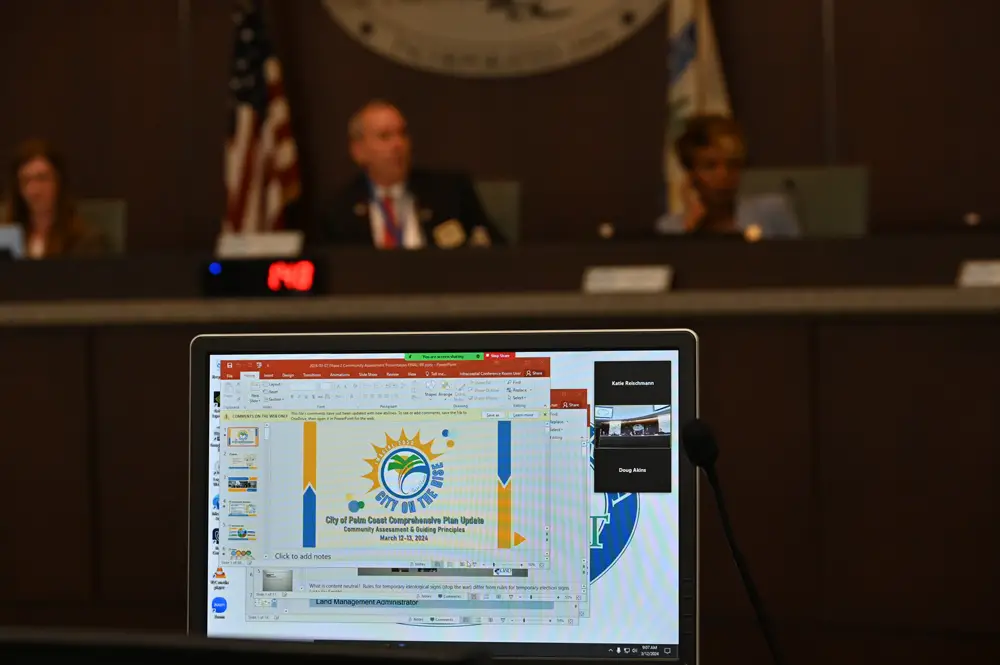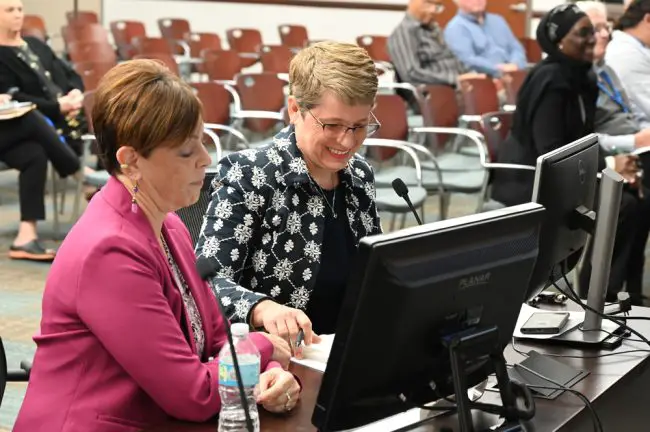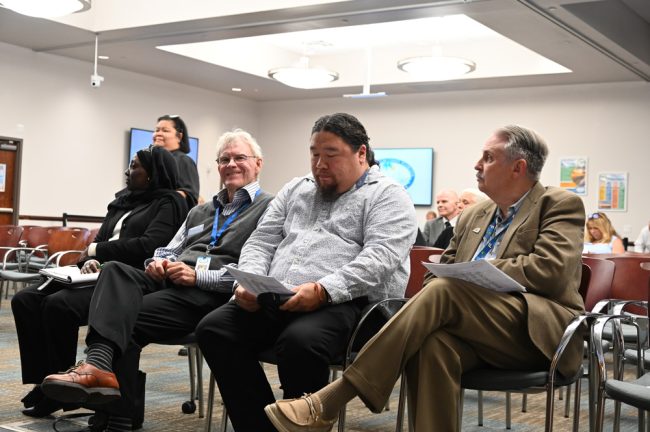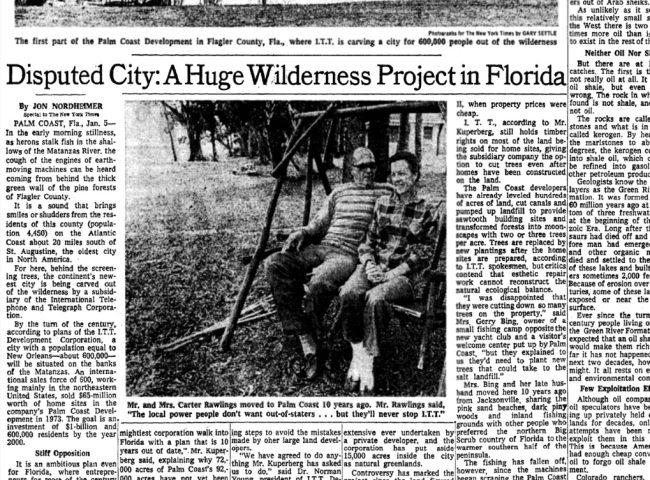
In Brief: Preserve the city’s greenery, temper growth, manage roads, bring in more businesses and arts and culture choices: those are some of the major themes gathered from thousands of interactions with Palm Coast residents and synthesized for the Palm Coast City Council today as it heard a mid-point update in its year-long rewrite of the city’s Comprehensive Plan, the long-term blueprint for growth and how the city imagines itself at half century.
![]()
It’s not nearly as poetic as Italo Calvino’s Invisible Cities–the surreal 1972 novel imagining 55 non-existent cities through the dialogues of Marco Polo and Kublai Khan–but it’s the nearly same idea, applied to Palm Coast: how would you, 100,000 Polos and Khans, re-imagine the very city you’re living in?
City staffers and their consultants, Kathie Ebaugh and Silvia Vargas of Gainesville-based JB Pro, a planning and construction company, have been having a few hundred, possibly a thousand or two, conversations and interactions with and innumerable sticky-note suggestions from residents since launching the Imagine 2050 initiative last October. “We’ve had 2,000 opportunities to talk to people at pop up events and portable meetings,” Ebaugh said.
It’s all geared toward a rewrite of the city’s Comprehensive Plan, whose last edition goes back 20 years.
A Comprehensive Plan is a city’s guiding blueprint in big brushstrokes. It doesn’t tell you how many parks, subdivisions and apartment complexes there should be, or where specifically they should go, but it sets out the general balance between the three and draws out general boundaries where they may or may not be. It lays out a long-range plan for roads and public transportation (if feasible), determines what sort of place residents want for arts and culture, and so on. Put another way: Imagine 2050 is the Invisible City at half-century.

On Tuesday, Ebaugh, Vargas and city staffers presented the results of their findings through the first phase of Imagine 2015, on the eve of launching the second phase Wednesday in public sessions at City Hall. They synthesized all those contacts with residents into a dozen themes and a draft vision statement. “So you have these broad themes that now you start establishing your goals for those things,” Ray Tyner, the city’s planning director, told the City Council. “Then you started doing objectives and policies. That’s where the detail comes in.” (See the full presentation here or at the foot of the article, and the video of the meeting below that.)
Here are some key themes:
- Residents love their small town tranquility, a sense of community pride and engagement, the low taxes and the family-friendly neighborhoods, and their natural environment: trails, parks, accessible ocean. That environment is “the first thing that came through and it’s, I would say, the top thing that we have,” Vargas said.
- Residents have concerns. Topmost: Overdevelopment. Overcrowding. The changes in community character. Traffic congestion. And of course, that specialty in Palm Coast, where certain forms of discrimination, if not bigotry, are still considered a norm: opposition to apartment complexes. “We heard a lot about multifamily development and we heard about a lot about loss of green space, which as I said, is what people love the most,” Vargas said. They love the green spaces. They don’t love the apartment complexes. (Cities cannot function with a reliable workforce and vibrant cultural scene without apartments and moderate-cost housing, but Palm Coast has not made that leap.)
- Residents complain of the lack of public transportation, as they have for two decades, not just in Palm Coast. They complain of a lack of business diversity: they want more and better restaurants, more grocery stores, a more varied art scenes (all those things that, without moderately priced housing like apartment complexes, is difficult to achieve in a city.)
- Ironically, while there are “concerns” about apartment complexes, Palm Coast residents also want better housing affordability. (The median price of a home in January was $380,000 in Flagler-Palm Coast, according to the Flagler County Association of Realtors.) They want better-controlled growth. They want a built-up Town Center (something the city has been striving for since building the Town center infrastructure starting in 2003). They want an improved tree canopy, and good schools. And they want to maintain that sense of a small town.
“It was not really created to be a small town,” Vargas said. “It’s a platted city of 62,000-plus acres, of which 42,000 acres were the original ITT plat. There were 50,000 home sites that were sort of designed for a population of over 100,000 people. That’s hardly a small town.” In fact, Vargas was undercounting ITT’s plan by a factor of six: when The New York Times devoted a lengthy article to ITT’s designs on Palm Coast in 1974, as the subdivision was already growing fast, it reported that “By the turn of the century, according to plans of the I.T.T. Development Corporation, a city with a population equal to New Orleans–about 600,000–will be situated on the banks of the Matanzas.” Even the planned West Side expansion will not get Palm Coast there just yet, but such ambitions are not necessarily entombed in ITT’s archives.
“But the city has been able to maintain that small town feel. And people love that and this is why they’re coming here. And so it’s one of the things that people aspire to protect and maintain,” Vargas said, before noting the massive developments Palm Coast has approved (they’re called “Developments of Regional Impact”) only two of which are active. The other three are awaiting bulldozers. They total 22,000 lots,in addition to the 10,000 to 12,000 or so lots remaining in the older part of Palm Coast. The combined lots alone would nearly double the city’s population if built and occupied in the next 20 years.
Vargas projects a population of 165,000 in 2050, in a city with a median age of over 50 years old and getting older–far older than the national median. Almost a third of the city’s population is over 65, a proportion that is getting larger, in a nation where that proportion is half that (though gaining on Palm Coast’s). “Your community as a whole is aging,” Vargas said. “And that has very, very interesting and clear and impactful implications for the kinds of development and services that are going to have to be provided in the future.”

The presentation was heavy on demographic numbers, trends, percentages delivered in relentless packets of analysis that made it difficult to immediately digest. And it’s not over. “This is not our whole assessment by any means, and it’s a work in progress. We’re still collecting data,” Vargas said. And while richly informative, it more often summarized the known and understood than it provided new information.
“You have two medical facilities, one library that’s operated by the county and one detention facility that’s also operated by the county, and then you have an array of other services and support programs that address things like your arts programs,” Ebaugh said, for example. Why it was important to know that in the context of the comprehensive plan discussion wasn’t clear. She spoke of the city’s stormwater challenges, which are well known, and noted that they were inherited from ITT–a decreasingly accurate claim as the city marks its quarter century–but how that will fit into the comprehensive plan (beyond the recent near-doubling increase in stormwater fees to contend with the decrepit inheritance) is also unclear.
The consultants were also here to give a bit of policy guidance to the council as well, translating their data packets into more practical imaginings for their city. Some of those points would be more obvious to residents than apparent, such as the alignment of the city’s infrastructure and capacities with the pace of development, or more obvious than desired, such as the diversification of the housing stock to serve all future population needs. There’s also that perennial desire that every almost elected official has included in his, her or their platform for decades: attracting employment and finding a way to keep workers closer to home rather than commuting to other counties.
For now, the guidance is more along the lines of the draft vision statement the consultants are proposing than actual policy blueprints. “We hope to see in 2050 Palm Coast be the flagship of Flagler County and Northeast Florida,” Vargas said. “A vibrant, attractive, diverse community known for sustainable development that seamlessly and harmoniously coexists with, embraces and respects its natural environment.” That means “responsible growth and environmental stewardship, where the preservation of our natural resources and beauty is paramount.”
Vargas went on, projecting “an array of resilient quality housing, good paying jobs, new training and education institutions and a variety of retail culture, recreation and entertainment facilities and venues, all of which may be reached via multiple safe and convenient transportation modes. In 2050 Palm Coast celebrates diversity supports resiliency, and embraces a spirit of civic engagement, community collaboration and innovation. Palm Coast residents thrive in an environment that prioritizes wellbeing, inclusiveness, connection, creativity, curiosity, and lifelong learning. And finally, in 2050, Palm Coast extends fair opportunity, choice and prosperity to all who opt to make our city their home, whether for residence, work, study, play or repose. Preferably all ”
By then the presentation was more along the lines of dream republics and utopias than invisible cities (as in a presentation pre-approved by the DeSantis administration, the words climate change were not spoken once). But nobody said a comprehensive plan shouldn’t be inspired by idealism, keeping in mind that even ITT’s lawyer in Palm Coast had read Thomas Moore (he confirmed it to FlaglerLive today), and that Palm Coast was imagined as no less of a utopia back then, if one of 600,000 souls already by the time it was incorporated.

Council embers lavished praise on the consultants’ work, with notable asides: “I haven’t heard anything in the strategic action plan about how we can better accommodate our disabled or handicapped citizens,” Council member Cathy Heighter said, zeroing in on the inevitable corollary of the city’s aging population and future needs (and not just because of older people). Heighter wants more attention paid to physically and mentally challenged citizens. “I know that there’s not much of that being done here in the community, but I’d like to see more of that included into our Strategic Action Plan,” she said.
“I hope that myself and our council members we can kind of tie in these initiatives into our strategic action planning meetings that we’ve been having,” Council member Nick Klufas said, referring to the council’s annual goals. “I think that’s something that if they don’t overlap, then I think we’re not necessarily doing our job because this is direct feedback from the residents. And one of my biggest strategic action planning items for this year is our arts art scene, or arts destination. I think that’s something that I want to make sure that us as a council, but also the public realizes: a tremendous amount of people are looking for an art scene, and a dedicated art scene.” He is proposing breaking the arts out of the parks and recreation department, as a division of its own. (Klufas, in his eighth year on the council, was instrumental in creating the arts district in Town Center, but he is term-limited and is running for a County Commission seat.)
There’s still some way to go, if not that much of a long way, for the comprehensive plan process, which is not expected to have a drafted product until June. That will go before the council for at least a pair of workshops before the plan is approved in a pair of public hearings in August and September–the first to be followed by the plan’s transmission to the state for approval (a pro forma process: the state has all but shrugged off its planning responsibilities it fostered under Reuben Askew, at least since the days of Jeb Bush). The comprehensive plan will then return for a second and final public hearing on Oct. 15.
Whether it becomes a living, binding document or joins others like it in archival memory holes will be up to the City Council, and future councils’ predilection for what has often spayed and neutered comprehensive plans: the comprehensive plan amendment.
![]()
Public participation note: Palm Coast Imagine 2050 Phase 2 Kick-Off Public Meeting on March 13, consisting of two community conversation workshop meetings to delve into the community’s themes and core planning values, derived from extensive public engagement efforts during Phase 1. There are two opportunities to participate: the first workshop is from 1:00 p.m. to 3 p.m. and the second is from 5:30 p.m. to 7:30 p.m. in the Community Wing of City Hall, located at 160 Lake Ave, Palm Coast. The workshop will include a presentation and small group discussion. This event is open to the public, welcoming all residents who wish to contribute their ideas and perspectives to the comprehensive planning process.
comprehensive-plan-update-2024








